The mass extinction of the dinosaurs, approximately 65.5 million years ago, is inferred by most scientists to have been caused by
(1) a large energy surge from the surface of the Sun
(2) the occurrence of a major ice age
(3) an impact event occurring on Earth’s surface
(4) earthquakes occurring along crustal plate boundaries
(3) an impact event occurring on Earth’s surface
Water is returned from Earth’s surface to the atmosphere by
(1) condensation and transpiration
(2) condensation and precipitation
(3) evaporation and transpiration
(4) evaporation and precipitation
(3) evaporation and transpiration
Which type of sediment sample normally has the greatest permeability rate?
(1) unsorted pebbles
(2) sorted pebbles
(3) unsorted sand
(4) sorted sand
(2) sorted pebbles
Which gas is most effective in absorbing incoming harmful ultraviolet radiation in Earth’s stratosphere before that radiation reaches Earth’s surface?
(1) nitrogen (2) oxygen (3) hydrogen (4) ozone
(4) ozone
The cross section below represents the bedrock structure of a section of Earth’s crust. Letters A through H represent rock units. Line XY represents a fault. The rock layers have not been overturned.
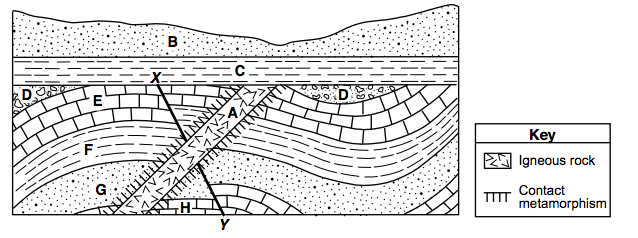
When did faulting along line XY occur?
(1) after the intrusion of rock unit A
(2) after the formation of rock units E and F
(3) after the deposition of rock units B, C, and D
(4) before the formation of rock units G and H
(2) after the formation of rock units E and F
Which life-form existed on Earth for the shortest period of time?
(1) dinosaurs
(2) ammonoids
(3) trilobites
(4) placoderm fish
(4) placoderm fish
Which surface ocean current transports cool water to lower latitudes?
(1) Gulf Stream
(2) Peru Current
(3) West Greenland Current
(4) East Australia Current
(2) Peru Current
Which geologic feature is composed of the youngest crustal bedrock?
(1) Peru-Chile Trench
(2) Mid-Atlantic Ridge
(3) Adirondack Mountains
(4) San Andreas Fault
(2) Mid-Atlantic Ridge
As altitude increases in the troposphere and stratosphere, the air temperature
(1) decreases in the troposphere and increases in the stratosphere
(2) decreases in both the troposphere and stratosphere
(3) increases in the troposphere and decreases in the stratosphere
(4) increases in both the troposphere and stratosphere
(1) decreases in the troposphere and increases in the stratosphere
The cross section below represents rock units within Earth’s crust.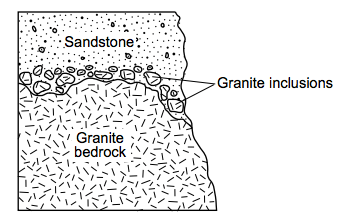
The age of the granite that makes up the inclusions is most likely
(1) older than the sandstone, but the same age as the granite bedrock
(2) older than the sandstone and the granite bedrock
(3) younger than the sandstone, but the same age as the granite bedrock
(4) younger than the sandstone and the granite bedrock
(1) older than the sandstone, but the same age as the granite bedrock
The map below shows the location of the Chicxulub impact crater, which was formed in the Gulf of Mexico approximately 65.5 million years ago. With an estimated 108-mile diameter, this crater, which is now buried beneath surface crustal rocks, is one of the largest craters on Earth.

The asteroid impact that formed this large crater is theorized to have caused
(1) a drop in sea level from the sea water draining into the large crater
(2) warmer than normal worldwide ocean temperatures from the hot asteroid
(3) mass extinctions of many species on Earth from extreme climate changes
(4) an increase in worldwide greenhouse gases from vaporizing crustal rocks
(3) mass extinctions of many species on Earth from extreme climate changes
Which change in the heat energy content of water occurs when water changes phase from a liquid to a solid?
(1) gain of 334 Joules of heat energy per gram
(2) release of 334 Joules of heat energy per gram
(3) gain of 2260 Joules of heat energy per gram
(4) release of 2260 Joules of heat energy per gram
(4) release of 2260 Joules of heat energy per gram
The convection currents responsible for moving tectonic plates occur in which Earth layer?
(1) crust
(2) stiffer mantle
(3) rigid mantle
(4) asthenosphere
(2) stiffer mantle
Most scientists infer that a major factor in the increased rate of melting of Earth’s glaciers is
(1) a decrease in the output of energy from the Sun
(2) a decrease in Earth’s atmospheric transparency
(3) an increase in Earth’s orbital distance from the Sun
(4) an increase in carbon dioxide in Earth’s atmosphere
(4) an increase in carbon dioxide in Earth’s atmosphere
A portion of the Generalized Landscape Regions of New York State map below shows the location of the Catskill Aqueduct that flows into the Kensico Reservoir, which supplies the residents of New York City with drinkable water.
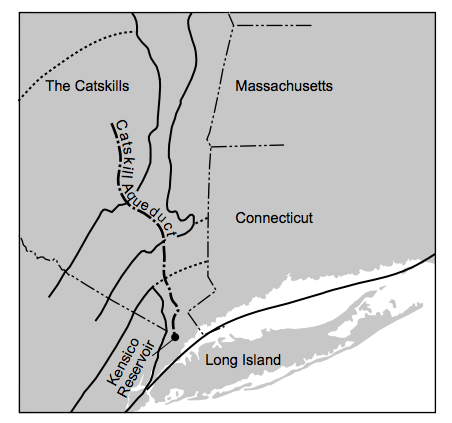 Which sequence shows the order of landscape regions that are crossed as water flows through the Catskill
Aqueduct?
Which sequence shows the order of landscape regions that are crossed as water flows through the Catskill
Aqueduct?
(1) Allegheny Plateau, Hudson-Mohawk Lowlands, Taconic Mountains, Newark Lowlands
(2) Allegheny Plateau, Hudson-Mohawk Lowlands, Hudson Highlands, Manhattan Prong
(3) Atlantic Coastal Plain, Newark Lowlands, Hudson Highlands, Hudson-Mohawk Lowlands
(4) Atlantic Coastal Plain, Manhattan Prong, Hudson Highlands, Allegheny Plateau
(2) Allegheny Plateau, Hudson-Mohawk Lowlands, Hudson Highlands, Manhattan Prong
What is the approximate percentage of geologic time that humans have existed on Earth since its origin?
(1) less than 1%
(2) 11.8%
(3) 1.8%
(4) more than 25%
(1) less than 1%
Which factor causes the surface of Lake Ontario to cool at a slower rate than the surface of the land along the shore of the lake?
(1) Evaporating water releases more heat into the lake than into the land.
(2) Lake water has a higher specific heat than land.
(3) Water vapor cools the lake as it condenses.
(4) Sunlight passes through the top layers of the lake water.
(2) Lake water has a higher specific heat than land.
What are the rock name and map symbol used to represent the sedimentary rock that has a grain size of 0.006 to 0.2 centimeters?
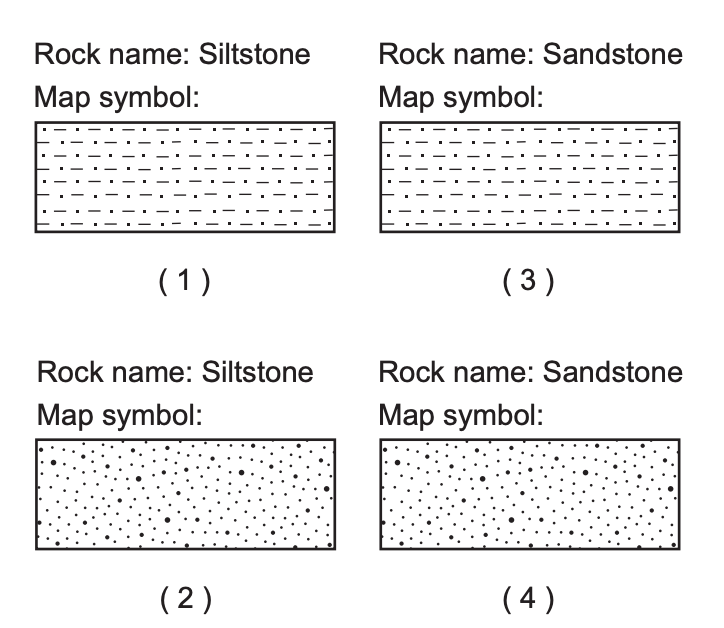
4 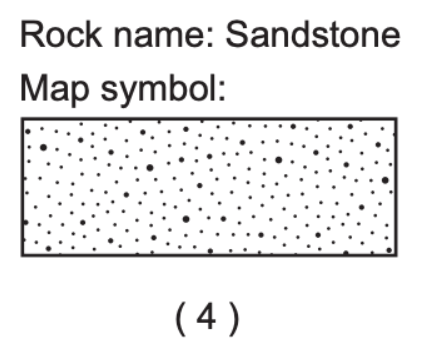
Which condition will most likely result in the formation of a cloud?
(1) wind speed decreasing
(2) air pressure increasing
(3) cool, moist air sinking
(4) warm, moist air rising
(3) cool, moist air sinking
During a rainstorm, water is flowing down the side of a hill composed of solid bedrock. What will be the effect on the relative amounts of runoff and infiltration when the water reaches an area of unsaturated soil with a gentler slope?
(1) Runoff will decrease as infiltration decreases.
(2) Runoff will decrease as infiltration increases.
(3) Runoff will increase as infiltration decreases.
(4) Runoff will increase as infiltration increases.
(2) Runoff will decrease as infiltration increases.
During which geologic epoch does the New York State rock record consist of weakly consolidated to unconsolidated sediments?
(1) Early Permian
(2) Late Cretaceous
(3) Early Jurassic
(4) Pliocene
(2) Late Cretaceous
Which ocean current brings warm water to the southeastern coast of Africa?
(1) Agulhas Current
(2) Benguela Current
(3) West Australian Current
(4) Equatorial Countercurrent
(1) Agulhas Current
The cross sections below represent three bedrock outcrops found several kilometers apart.
 Which statement best explains why the volcanic ash layers are useful for correlating the relative ages of the
bedrock in the three outcrops?
Which statement best explains why the volcanic ash layers are useful for correlating the relative ages of the
bedrock in the three outcrops?
(1) The ash was deposited over a large area when a volcano erupted.
(2) There are no fossils found within the volcanic ash.
(3) The volcanic eruptions that produced the ash layer occurred over a long period of geologic time.
(4) The volcanic ash is found between many different layers of bedrock.
(1) The ash was deposited over a large area when a volcano erupted.
Which condition will most likely result in the formation of a cloud?
(1) wind speed decreasing (2) air pressure increasing (3) cool, moist air sinking (4) warm, moist air rising
(3) cool, moist air sinking
The geologic cross section below represents surface landscape features that developed in an arid climate.
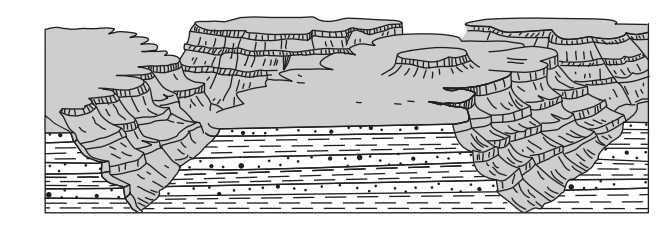
A change in climate to one that is more humid would cause the
(1) shape of the hills to become more rounded
(2) elevation of the area to become higher
(3) porosity of the bedrock to increase
(4) rate of chemical weathering to decrease
(1) shape of the hills to become more rounded